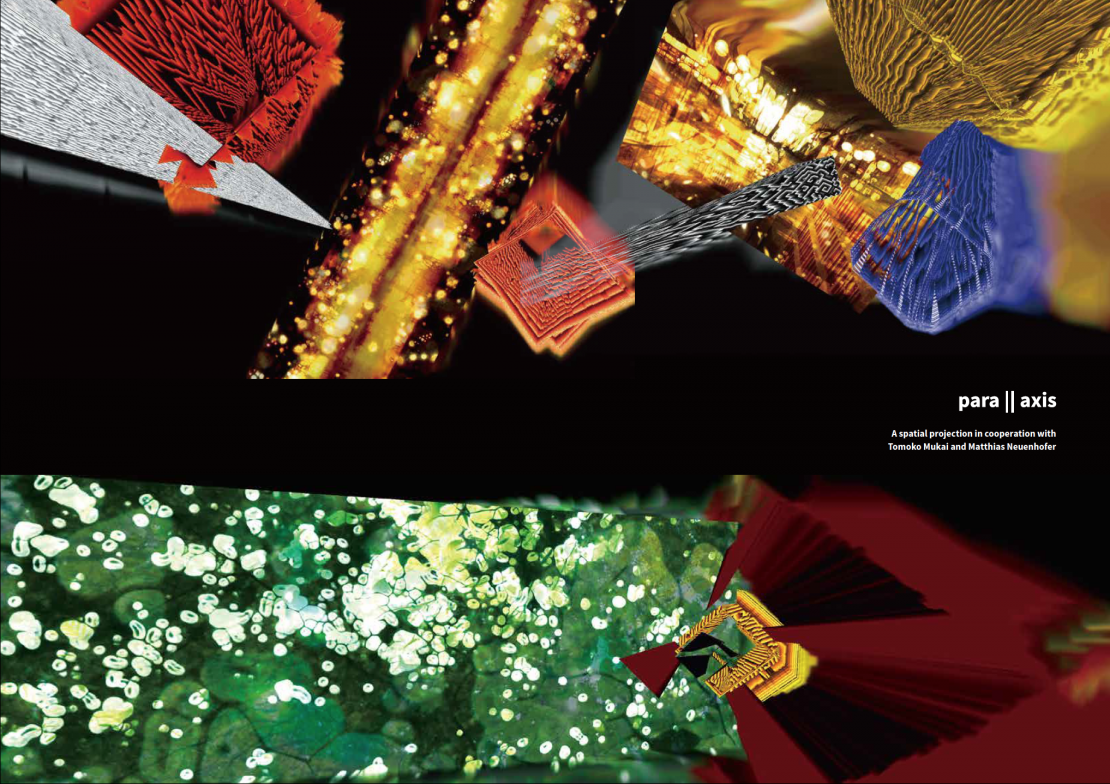TOMOKO MUKAI | raumraum
Works | Biography [Japanese][English]
KIWA PROJECT
‘Kiwa’ means a spatial edge or boundary; but it also symbolizes an extreme moment in the metamorphosis of things.
KIWA Project aims to create platforms for creation and dialogue through observing the relationships between urban images and “constructed nature” from across the globe and with the Japanese perspective of “Fudo” (climate). It emphasizes the coming and going of dialogue of diverse peoples from different fields and positions, as well as people with various types of perceptual characteristics.
This project consists of a complex program, including outdoor and indoor audiovisual performances, workshops, public talks, a series dialogue on website. Audio visual performance “At the Kiwa (Kiwa ni Tatsu)” was as a part of the Tokyo Tokyo FESTIVAL (TTF) in 2021.
きわ(際)とは、空間的な境界線であると同時に 事物が変化する極限的な瞬間をさす
「風土」という日本のパースペクティブから、世界各地の都市と「構築された自然」を観察し、さまざまな立場や特性を持った人々が関わりあいながら、対話や制作の場を創出するのが「きわプロジェクト」です。このプロジェクトは、屋内外の映像音響公演、ワークショップ、公開トーク、ウェブ対談「きわダイアローグ」などの、複合的なプログラムから構成されています。本公演「きわにたつ」は、2020-2021年に向けて多彩な文化プログラムを展開し、芸術文化都市東京の魅力を伝える取り組みである「Tokyo Tokyo FESTIVAL」のプログラムの一つです。
Project Web Site | プロジェクトウェブサイト| http://kiwa-project.org/
Audio Visual Performance “At the Kiwa”
Co-creation of Public Projection and Hamon Performance
映像音響公演「きわにたつ」
Audio Visual Performance “Touching Kiwa”
Co-creation of Panorama Projection and Hamon Performance
映像音響公演「きわにふれる」
———-
Landscape Scroll of the Four Seasons by Sesshu Toyo
A panorama projection with an AR system “Landscape Scroll of the Four Seasons by Sesshu Toyo”
Yamaguchi Prefectural Art Museum, Tokyo, Yamaguchi, 2019
Production
“Landscape Scroll of the Four Seasons by Sesshu Toyo”
National Treasure, Mohri Museum Collection
dated 1486, handscroll, ink and light colors on paper, 40.8×1602.3cm
Special cooperation: Mohri Museum Co. Ltd.
Photographed by Seiji Shirono [National Institutes for Cultural Heritage, Tokyo National Research Institute for Cultural Properties]
Creative director: Tomoko Mukai
Technical director: Shiro Yamamoto
Curator: Mami Okamoto [Yamaguchi Prefectural Art Museum]
Executive producer: Michitaka Kono [Yamaguchi Prefectural Art Museum]
© 2019 Museum Town Yamaguchi Executive Committee
———-
The 1000 Year Unicorn
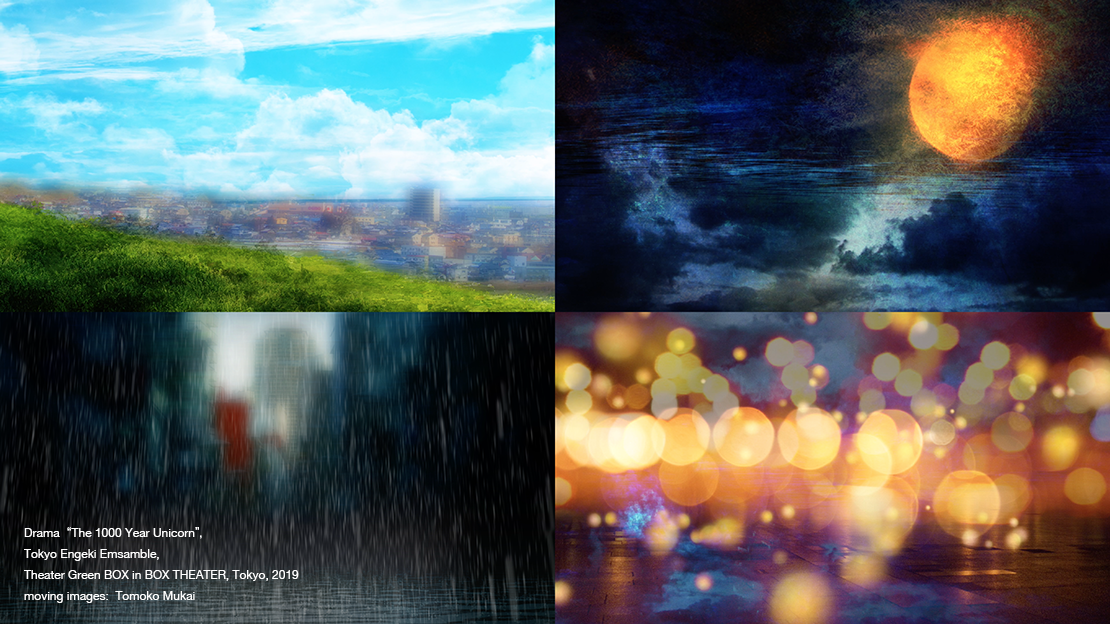
Drama “The 1000 Year Unicorn”
Tokyo Engeki Ensemble, Theater Green BOX in BOX THEATER, Tokyo, Japan, 2019
Production
The original: Yu Okita | Instruction and direction: Yoshinori Kouke | Music: Ken Kaizu | Stage design: Tomoko Inamura + Yoshinori Kouke | Costume design: Tomoko Inamura | Moving images: Tomoko Mukai | Sound engineering: Takeshi Shima | Lighting: Chieko Makabe | Advertising art: Takayuki Kubo + Kei Okuaki | Stage director: Yuya Shinohara | Produced by Akiko Komori + Akira Ota + Takako Kashio
Cast
Tomoko Yamazaki as Anne | Wataru Nagahama as Maruo | Kisetsu Mano as an old woman of the gallery and Anne’s grandmother | Toshiya Kobayashi as Anne’s father and unicorn | Hiroko Nasu as Paia, ironmonger and news anchor | Sumihiko Asai as Peruda, a man of the furniture shop and announcer | Yuya Shinohara as Ratatosk, reporter, a man of the repair shop and student B | Yuichiro Ohashi as Skol, a buyer of the buddha statue and student A
“The 1000 Year Unicorn” was shown as the premiere of a stage by Tokyo Engeki Ensemble. The original book was written by a high school teacher. This drama focuses on the feeling of despair of today from “Ijime (hazing)” in the school life to the global issues. It describes how to communicate with others in a global sense of obstruction. This stage will go on tour as a travel performance for schools and teenagers all over the country from 2020.
The natural environment like the moon, blue sky, rain, rivers and hill in the moving images represented the background of the stage, and at the same time, symbolized roles as watching over the characters and the drama, and the outside world that the characters overlook in their despair.
『千年ユニコーン』 は、10代の若者を取り巻く「いじめ」の問題を中心に、今日の世界中に溢れる閉塞感の中で、「他者に伝える」ことの意味を描く。本公演は、現役の高校教師による書き下ろしで、東京演劇アンサンブルの演出により初演として上演された。2020年以降、全国の学校や10代の若者を対象に巡回公演を行う。
本公演の映像演出では、月、青空、雨、川、丘といった周囲の自然環境が、舞台の背景としてだけではなく、ときに舞台上の登場人物やドラマを見守り、ときに登場人物が閉塞感の中で、見渡すことのできる外の世界を暗示している。
———-
open paths
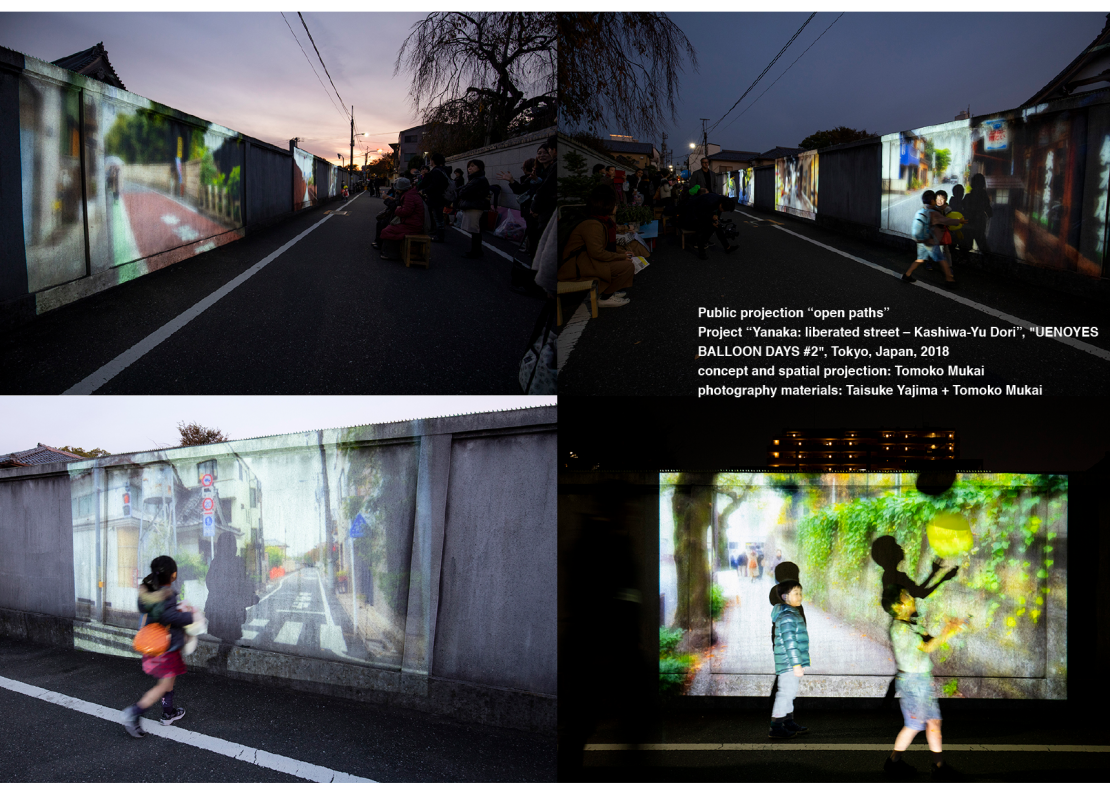
Public projection “open paths”
Project “Yanaka: liberated street – Kashiwa-Yu Dori”, “UENOYES BALLOON DAYS #2”, Yanaka, Tokyo, Japan, 2018
concept and spatial projection: Tomoko Mukai
photography materials: Tomoko Mukai + Taisuke Yajima
documentation:
photography: Taisuke Yajima
videography: Takuma Kamaishi
The public projection “open paths” was shown as a part of the project “Yanaka: liberated street – Kashiwa-Yu Dori (street)”, “UENOYES BALLOON DAYS #2”. The Yanaka area of Tokyo is not only a very notable place with many historical temples but also a place as the centre of modern Japanese art history. In the project “Yanaka: liberated street – Kashiwa-Yu Dori”, an 80m-street in Yanaka was open as a pedestrian paradise to citizens and artists all day. Various kinds of their activities were held during the day such as participatory works by artists and citizens, workshops, dances and music performances hybrid as what they wanted to do.
The projection “open paths” was held in the evening around the end of this project. Images of over 150 streets, which connote “passages” to historical and cultural places in Yanaka, were projected onto a long wall of a temple at “Kashiwa-yu Dori”. At the same time, real shadows of observers at “Kashiwa-Yu Dori” were projected overlapped onto images of those streets. It means, those projected images contained not only images of past memories in this area, but also evoked images that people might encounter at those streets in future.
谷中解放区「柏湯通り」
UENOYES バルーンDAYS #2では、かつて「柏湯」という銭湯で、現在は現代美術ギャラリーSCAI THE BATHHOUSEとなっている建物の前の道路を一日限定で「柏湯通り」と名づけ、アートのための歩行者天国として解放し、プロジェクト「谷中解放区」を実施した。暖かい秋空の下、この約80mの1本の道には、このプロジェクトのために制作された座机が一直線に並び、アーティストによる参加型の作品やワークショップ、神出鬼没のダンス、音楽パフォーマンスなど、多様な表現が路上で繰り広げられる。また一方で、一般市民も各自がやりたいことを持ちより、机を囲み。表現することと日常が、穏やかに混ざり合い、生き生きとした道の装いをつくりだす。
open pathsは、谷中解放区「柏湯通り」も終盤を迎え、西空が夕焼けに染まり始めた頃から開催された。谷中の通りのひとつである、「柏湯通り」沿いの寺院の壁には、谷中の150箇所以上のさまざまな小道を映し出される。「open path」は、英語では「道を切り拓く」という意味をもつ。この作品のタイトルは、「open paths」と、複数形で表記され、谷中にあるたくさんの小道を暗示する。「柏湯通り」に投影される各小道は、今いるこの道(柏湯通り)が、それらの道とつながっていることを思い出させるとともに、地域一帯の暮らし・歴史・文化とのつながりをも連想させる。また、投影されている小道には、柏湯通りに実際にいる人たちの影が映り込み、観ている人それぞれが、この先、それらの道で、出会ったり、生まれたりするかもしれないコトゴトに想像をめぐらせていく。
———-
Spatial projection for yoga and meditation exercise

Spatial projection for yoga and meditation exercise,
Mao Imai (Yogini) + Reiko Yoneyama (Yogini) + Tomoko Mukai
&moment, Tokyo, Japan, 2018
documentation:
photography: Taisuke Yajima
videography: Mizuho Seko
———-
Distances

Spatial projection “Distances”
composed by Hiroyuki Itoh, Regular performance 2018 of Ensemble Contemporary α, Commemorating the 20th anniversary of “Bach’s birth to 333”, Recital Hall, Tokyo Opera City, Tokyo, Japan, 2018
documentation:
photography: Taisuke Yajima
video camera: Riyoko Sugiura, Mizuho Seko, Yuma Nishimura
video editing: Riyoko Sugiura
———-
Landscape Scroll of the Four Seasons by Sesshu Toyo

Exhibition design for “Landscape Scroll of the Four Seasons by Sesshu Toyo”
National Treasure (collection of Mouri Museum), exhibited at Yamaguchi Prefectural Art Museum, Yamaguchi, Japan, 2006, 2009, 2014–2017
Since 2006, this continuous project is ongoing in cooperation with Yamaguchi Prefectural Art Museum. “Landscape Scroll of the Four Seasons by Sesshu Toyo” is drawn by one of the Japanese outstanding painters of Suiboku-ga (ink-wash painting), Toyo Sesshu in 15th Century. This masterpiece is owed as a national treasure by Mouri Museum and is shown to the public almost once a year only at that museum. The total length of this work is about 16m, therefore, it is not easy for museum visitors to observe it carefully. This project aims to convey the attraction of this masterpiece by using moving images through 4K monitors or projections that cannot be by the usual display of the original. Those exhibition designs make it possible to let museum visitors observe its details and evoke them the feelings surrounded by this landscape scroll. In addition, workshops for children were held by the utilization of local databases for cultural properties as a part of this project.
2006年より現在まで山口県立美術館との継続プロジェクトとして、雪舟等楊筆『四季山水図』通称『山水長巻』(国宝・毛利博物館)の映像展示デザインに取り組んでいる。同山水画は、雪舟を代表する大作であるが、原物鑑賞は1年に1度の毛利博物館でも公開にほぼ限られ、また、全長約16mがおよぶため、一般の人が丹念に鑑賞することは難しい。そのため鑑賞者が、山水画の細部を観察したり、壮大な山水画の世界に囲まれたりと、原物の鑑賞だけでは伝えきれないこの名作の魅力を伝えるために、様々な映像展示を提案し公開している。また、このプロジェクトの一環として地元の各種文化財データベースを活用した、子どものためのワークショップなども実施。
documentation:
photography: Tomoko Mukai
———-
para || axis

para ll axis booklet
para || axis
Tomoko Mukai + Matthias Neuenhofer (media artist)
St.Gertrud, Cologne, Germany, 2017
documentation:
photography: Tomoko Mukai + Matthias Neuenhofer
para || axis is a project that gradually brings into focus the potential of a place through observation of things and phenomenon on site from various positions. It stirs the imagination of a parallel world, twists of space and time, the possibility that diverse things and phenomenon will be generated.
“para || axis” is derived from an ancient Greek word “Parallaxis”, which is the origin of the word “parallax.” The word “parallax” in astronomical terminology means the apparent change in the position of a heavenly body when that object is observed from two different positions. Human beings use parallax to gain depth perception from their two eyes. The Greek prefix “para” means “besides” or “beyond” and is associated with the word “parallel.” The word “axis” means basic lines or principal structure of a three-dimensional body. Two vertical lines “ || ” between “para” and “axis” are associated with “OR” in the programming language C.
St. Gertrud is a Catholic church in St. Agnes Parish, Cologne, Germany, which was designed by German architect, Gottfried Böhm in the 1960s. Because the city of Cologne was bombed during World War II, the reconstruction and building of the churches and chapels were important projects for local people after the war. Today this church is not only a place of worship but also a historically and culturally significant site in the city. Especially it is led through »sankt gertrud: kirche + kultur« as a special site for cultural communication.
Gottfried Böhm (1920-, Germany) is a German architect, who combined traditional architectural styles with modern materials and sculptural forms. His outstanding works are church designs after World War II. He was awarded the world-famous Pritzker Architecture Prize as the first German architect in 1986.
para || axisとは、 「parallax(パララックス・視差)」の語源である、古代ギリシャ語の「parallaxis(パララクシス)」に由来する。「parallax」は、天体を観測する際、位置によって、対象物の見え方が異なることを指す天文用語であり、また、 人間が右目と左目の視差を利用して奥行きを知覚することを指す言葉でもある。古代ギリシャ語の接頭語「para(パラ)」は、「〜と隣接する」「〜を超える」を意味し、「parallel(平行)」を連想させ、「axis(アクシス)」は、3次元物体の主軸線のことを意味する。「para」と「axis」の間の「 || 」は、プログラミング用語の「 OR 」を表す2本線を想起させる。
向井の映像は、街中のどこかで見た光の景色を喚起させる心象風景のようである。また同時に、その映像は現実の教会の丸い植物の形をしたステンドグラスや、そこから壁や床に木漏れる光とも呼応する。ノイエンホッファーは、教会の四角錐の天井構造を模したグラフックオブジェクトをプリセットに組み、磁場でイメージを生成させていく。また、GPSの情報をグラフィックオブジェクトに取り込むことで、ケルンの街中や教会内に存在する目には見えない情報を可視化する。双方の映像は、教会内で融合し、同期をとらず3方向の壁に投影される。瞬間的に発生する偶発的なコントラストの中で、お互いの映像が溶け合い、侵食し合い、ときには破壊し合い、建築の空間像を変容させていく。それはあたかも、パラレルワールドや時空のねじれが、その場所に存在するかのような予感をも感じさせる。そのようなプロセスの中で、街中の拠点、文化的メディアとしての建築自体の特性は増幅され、場所固有の潜在的な性質が浮かび上がってくる。
聖ゲルトゥルトゥ教会は1960年代にゴッドフリート・ベームによって設計され、今日では、祈りの場所としてだけでなく、ケルン市の重要な歴史的建造物として、また、芸術文化プログラムを実施する拠点として、さまざまな人々の集いの場所になっている。ゴッドフリート・ベームは、戦後ドイツの教会や礼拝堂の建設や再建に従事した建築家で、1986年、ドイツ人として初めて、世界的建築賞であるプリツカー賞を受賞している。
———-
Exhibiting Music – The Resonance of Forests

The digest of “Exhibiting Music”
Full Version of “In the Dim Light”
exhibiting music booklet
Exhibiting Music – The Resonance of Forests
Tomoko Mukai + Hiroyuki Itoh (composer)
spatial projection and contemporary music,
sonorium (designed by Jun Aoki), Tokyo, Japan, 2017
documentation:
photography: Taisuke Yajima
videography: Takuma Kamaishi
Exhibiting Music is a project in co-plan and cooperation with the composer Hiroyuki Itoh. It aims to create a spatial experience comprehensively with contemporary music and spatial projection.
『音楽の展覧会』は、向井知子(映像空間演出)と伊藤弘之(作曲家)が、映像絵画展とミニコンサートを融合させ、建築空間全体を総合演出するプロジェクトである。『音楽の展覧会: 森をめぐって』では、青木淳が設計した非対称のユニークな建築空間を立体的に演出した。伊藤が作曲した4つの楽曲から構成し、内3曲『迷宮の森』『In the Dim Light』『響きの森へ』で映像空間演出を行なった(1曲は、真っ暗闇の中で実施)。異なる領域の観客層を開拓するとともに、本公演とは別に「子どものためのミニ公演」も設け、難解と思われがちな現代音楽を、世代を超えて子どもたちにも開放。
Program
The Woods of Labyrinth for soprano saxophone: recorded sound source performed by Kohei Ueno, soprano saxophone
In the Dim Light: performed by Ryuta Nishikawa, conducting | Jun-ichiro Taku, alto flute | Ikuko Suzuki, clarinet | Madoka Sato, violin | Tomoki Tai, violoncello | Yumi Oikawa, piano
Yuragu Kaze wo Oru for vocal ensemble: recorded sound source performed by Vox humana (presented in the darkness without projection)
Deep into the Resonant Forest for piano solo: performed by Yumi Oikawa, piano
The Woods of Labyrinth
This spatial projection was created for the musical piece “The Woods of Labyrinth for soprano saxophone solo” composed by Hiroyuki Itoh in 2002, who originally was inspired by a public sculpture “Sunlight filtering through the woods with fruits” produced by Masayuki Hashimoto. He was impressed by a mass of metal with organic movements like living things and composed images of the vitality of the forest and the feeling of happiness such as sunlight filtering.
Most of its projected moving images were inspired by forests in Yakushima Island, Japan as the world natural heritage, where rich forests with diverse vegetation grow. It rains a lot there. Those forests contain plenty of water and strongly root on the ground. Many of the images were taken in the forests of Yakushima and edited to moving images by multilayered photographic images. Those images make us associate with “breathing” of the forest or the earth. The last scene was inspired by Brother Claus Chapel in Wachendorf, Germany designed by the renowned Swiss architect Peter Zumthor, which embodies the benevolence of nature. This scene evokes the passage to this chapel throughout a field of rapeseed.
『迷宮の森』は、伊藤弘之氏が、2002年埼玉県立美術館の委嘱として、橋本真之作の野外彫刻『果実の中の木もれ陽』(鍛金、埼玉県立美術館・北浦和公園)からインスピレーションをえて、ソプラノ・サクソフォーンのための楽曲として作曲したものである。「くねくねと曲がり、絡み合って繋がっているのです。琥珀色の鍛金の質感やうねりは、周囲の木々と一体化し、森の中の、なにか有機的な、大きな生きもののようなものに感じられます。また彫刻の胴体に空いた沢山の穴は、どこに繋がっていくのかわからない、吸い込まれていくような錯覚を覚えさせます。きらきらした木漏れ日が溢れるような、幸せなイメージをもって作曲した楽曲です。」(伊藤弘之氏との対話から、2014年)映像空間演出『迷宮の森』は、この伊藤の解釈を映像化したというよりも、どのような森と対峙したとき、このような音に出会うのかを想像したものである。全体に5場面から構成されており、主なイメージとしては、屋久島とペーター・ツムトア設計「ブラザー・クラウス野外礼拝堂」(ドイツ・メッヒェルニッヒ・ヴァッヒェンドルフ)に、この曲の森の原像を思い浮かべている。
Deep into the Resonant Forest
This spatial projection was created for the musical piece for “Deep into the Resonant Forest for piano solo” composed by Hiroyuki Itoh in 2007. For this piece, he did not have any particular motif derived from the existing forests. He imagined a forest consisting of the resonance created only by the composition of sounds of piano purely.
“This spatial projection was composed through the association with “particles” of sounds. The moving images consist of the fusion of various kinds of the computer-generated “particles” and multilayered photographic images. There is no narrative story, but a forest emerges from the collection of fragmented images of particles and those reflections.
『響きの森へ』は、2007年に伊藤弘之氏が、ピアノ・ソロのための楽曲として作曲したものである。具体的に存在する森を想定しておらず、純粋にピアノの音のコンポジションによって生まれる「響き」から森をイメージしている。伊藤氏の手書きの楽譜に打たれた音の布置は、とても視覚的で繊細で美しい。それは、まるで、光の粒子のようである。映像空間演出『響きの森へ』は、これら楽譜に配置された「音の粒子」から想起し、純粋にコンピュータ上で生成される様々な種類のパーティクルと線的要素を、写真イメージと多層に重ねて構成している。ナラティブなストーリー性は持たせておらず、光の粒子とそれらの反射から生まれる断片的イメージの集積から、森を生成する。色彩は、どちらかというとモノトーンによっているが、白黒の構成というよりは、黒と白の間に、漠々と広がる青と緑ののグラデーションを織り交ぜながら、光の粒子から森を生成している。
———-
Intersection Project 2014
Exhibiting Music + Live Concert: Juxtaposition / Crossing
The Woods of Labyrinth

The spatial projection “The Woods of Labyrinth”
composed by Hiroyuki Itoh,
Intersection Project 2014
“Exhibiting Music + Live Concert: Juxtaposition / Crossing”,
Tokyo Opera City Recital Hall, Tokyo, Japan, 2015
documentation:
photography: Io Nishimura
The Woods of Labyrinth
This spatial projection was created for the musical piece “The Woods of Labyrinth for soprano saxophone solo” composed by Hiroyuki Itoh in 2002, who originally was inspired by a public sculpture “Sunlight filtering through the woods with fruits” produced by Masayuki Hashimoto. He was impressed by a mass of metal with organic movements like living things and composed images of the vitality of the forest and the feeling of happiness such as sunlight filtering.
Most of its projected moving images were inspired by forests in Yakushima Island, Japan as the world natural heritage, where rich forests with diverse vegetation grow. It rains a lot there. Those forests contain plenty of water and strongly root on the ground. Many of the images were taken in the forests of Yakushima and edited to moving images by multilayered photographic images. Those images make us associate with “breathing” of the forest or the earth. The last scene was inspired by Brother Claus Chapel in Wachendorf, Germany designed by the renowned Swiss architect Peter Zumthor, which embodies the benevolence of nature. This scene evokes the passage to this chapel throughout a field of rapeseed.
———-
Cyan Blue
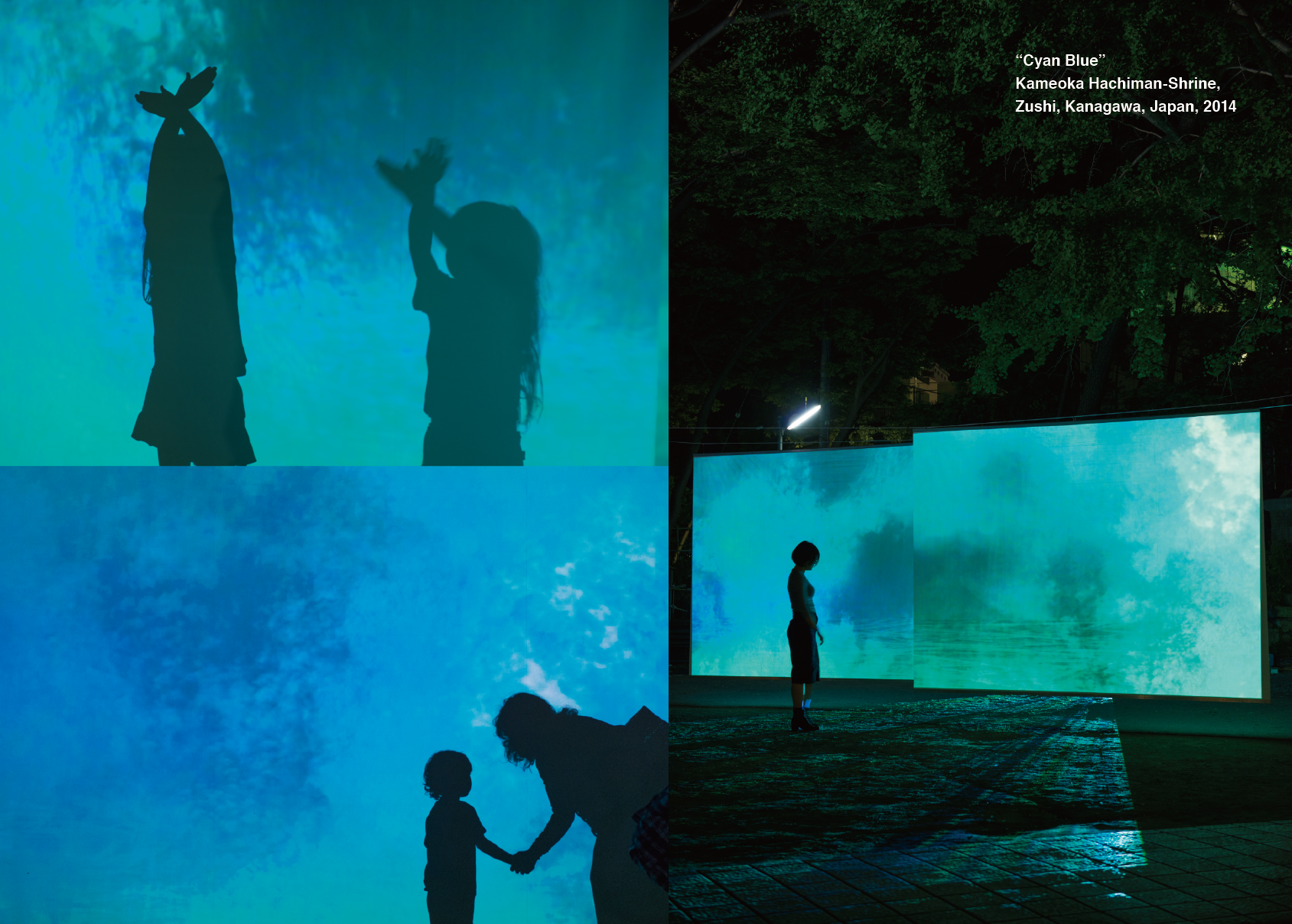
Cyan Blue
sound design by Ippei Ogura
Kameoka Hachiman-Shrine, MEDI–ARTz Zushi, Zushi, Kanagawa, Japan, 2014
documentation:
photography and videography: Kazuomi Furuya
The projected moving images are generated by the three primary colours RGB (red, green, blue) of light.
Cyan Blue projects a landscape that looks as if drawn with layers of CMYK (cyan, magenta, yellow, black) colours on the paper. It is based on my visual and physical memories of the time I used to draw perspectives with acrylic paint. As a related work, “Pink Gradation” was produced with the same concept.
映像は光の三原色RGB(赤・緑・青)を出力の基調とする。『Cyan Blue』 では、紙面にCMYK(シアン・マゼンタ・イエロー・ブラック)の層を重ねるように、絵画的質感を帯びた光景を投影する。絵の具でパースペクティヴを描いていた頃の視覚と身体の記憶を手がかりに、シアン・ブルーの光景を描いた。
———-
Intersection Project 2013
Parallel Crossing: Performative Architecture
Pink Gradation|Cyan Blue|Notation

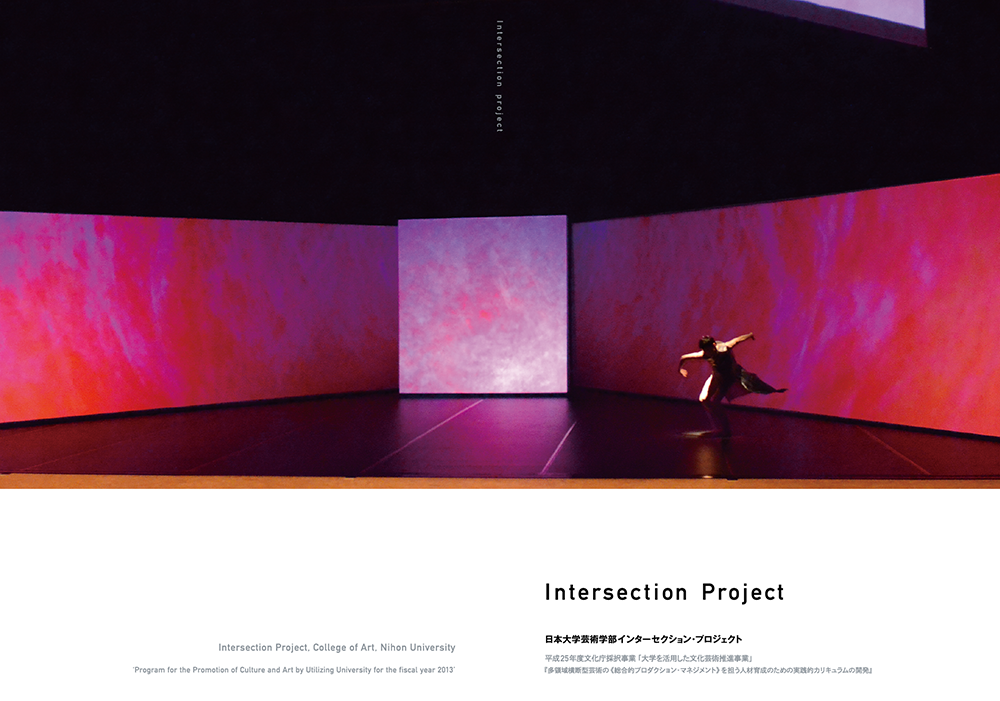
Intersection Project Publishings
Spatial projection “Pink gradation”|”Cyan Blue”|”Notation”
sound design by Ippei Ogura
Intersection Project 2013,
“Parallel Crossing: Performative Architecture”,
Middle Hall, College of Art, Nihon University, Tokyo, Japan, 2014
documentation:
photography: Satomi Tanaka
———-
Ichinosaka–River Landscape Project

Ichinosaka–River Landscape Project “Bridging Landscape”
sound design by ef end es
“HEART 2007”, organized by Museum Town Yamaguchi Committee, Yamaguchi Prefectural Cultural Federation, Yamaguchi Prefectural Board of Education, NPO Corporation of Children Station, Ichinosaka–River, Yamaguchi, Yamaguchi, Japan, 2007
documentation:
photography: Tomoji Iwai
———-
Suo no Kuni Project
Only white deep white

Spatial projection “Only white deep white”
sound design by Ippei Ogura
Hofu Tenmangu-Shrine (The oldest Tenmangu in Japan) and Suo Kokubun-Ji Temple, Yamaguchi, Japan, 2004
The related project to “completion ceremony of “Large Scale Heisei Era Conservation” of Suo Kokubun-Ji Temple
Qualified by Association for Corporate Support of the Arts, organized by Hofu City Foundation For Cultural Promotion, Yamaguchi Prefectural Tourism Federation, Hofu Chamber of Commerce & Industry, Hofu Sightseeing Product Association, Hofu Confectionery Association and others
documentation:
photography: Yozo Takada
Only white deep white – projection for art–Link
Only white deep white: Particles of a space

Spatial projection “Only white deep white – projection for art–Link”
sound design by Ippei Ogura
Public projections at three different historical- and cultural places in Ueno and Yanaka area, Tokyo University of the Arts, Tokyo National Museum (Main Building as Important Cultural Properties), Kanei-Ji Temple, Tokyo, Japan, 2002
The related project to “art-Link Ueno–Yanaka 2002”, organized by Tokyo University of the Arts, Tokyo National Museum, Executive Committee of art-Link Ueno–Yanaka 2002
documentation:
photography: Yozo Takada
“Only white deep white” and “Particles of a space”
Tomoko Mukai + Ippei Ogura, the performance with projected images and sounds, Sogakudo Concert Hall, Tokyo University of the Arts, Tokyo, Japan, 2003
documentation:
photography: Yozo Takada
———-
Only white deep white – between darkness and light

Spatial projection “Only white deep white – between darkness and light”
sound design by Ippei Ogura
Trinitatis church, Cologne, Germany, 1997
documentation:
photography: Oliver Schwabe
———-
Copyright © 1997-2019 Tomoko Mukai, All Rights Reserved.

